Best egg based dishes you must try in Lisbon

It won’t take you a long time after arriving in Portugal and eating out no matter where in the country you may be, to understand that the Portuguese love eggs. We feature them heavily in our savory dishes, and our repertory of cakes and pastries would certainly suffer from a severe change of identity if eggs were to be removed from our sweet recipes.
Nowadays, the average Portuguese eats 11 kilos of eggs a year, which is about 220 units. Considering the traditional Portuguese breakfast doesn’t even feature eggs, it’s quite remarkable how we still manage to squeeze in so many eggs during the rest of the day.
The generalization of eggs consumption in Portugal, and in Europe as a whole, dates back to the 5th century B.C., when the Romans started domesticating chickens. Eggs were sporadically eaten until then, collected from nests of several wild birds. But, from this moment onwards, having chickens at home guaranteed that you’d have one egg per animal, per day.
Over the centuries, the use of eggs proliferated as they represented a cheaper source of protein as compared to meat or fish. Furthermore, unlike other foods that were seasonal or needed to be preserved, eggs were available all year long.
It was inside convents starting in the 10th century, and even more so from after the 15th century when sugar became more widely available and increasingly more affordable, that the use of eggs was crucial for sweet creations that nowadays are part of Portugal’s edible history. We’re talking about conventual pastries, the range of Portuguese sweets that were back in those days developed inside religious institutions and that are (in)famous for the heavy use of eggs and, in particular, egg yolks.
Appetizers and petiscos
Ovos com farinheira
 Scrambled eggs in Portugal aren’t much of breakfast food. In fact, a typical Portuguese breakfast is very seldom a cooked affair. For us, scrambled eggs are more often than not considered a petisco, that is, a small portion or snack of savory food that we usually eat either as an appetizer or, along with more petiscos, as a full meal meant to be shared. As plain scrambled eggs wouldn’t be particularly exciting as a bite to be enjoyed with a glass of wine, the typical Portuguese kitchen mixes them with other substantial sources of flavor.
Scrambled eggs in Portugal aren’t much of breakfast food. In fact, a typical Portuguese breakfast is very seldom a cooked affair. For us, scrambled eggs are more often than not considered a petisco, that is, a small portion or snack of savory food that we usually eat either as an appetizer or, along with more petiscos, as a full meal meant to be shared. As plain scrambled eggs wouldn’t be particularly exciting as a bite to be enjoyed with a glass of wine, the typical Portuguese kitchen mixes them with other substantial sources of flavor.
Farinheira, a Portuguese sausage made with flour, pork fat and spices, is a typical addition to scrambled eggs. The fat content and the smoky undertones of this meaty bite add riches and depth of flavor to otherwise plain old eggs.
Try ovos com farinheira at Alcântara 50
📍Rua Vieira da Silva 50, 1350-187 Lisbon
Ovos verdes
 Scotland has Scotch eggs, first hard boiled and then deep-fried eggs with meat around them, and Portugal has ovos verdes, with a green stuffing. They both are ways of elevating boiled eggs and, in the case of Portugal’s “green eggs”, make for a fairly rare case of a vegetarian snack.
Scotland has Scotch eggs, first hard boiled and then deep-fried eggs with meat around them, and Portugal has ovos verdes, with a green stuffing. They both are ways of elevating boiled eggs and, in the case of Portugal’s “green eggs”, make for a fairly rare case of a vegetarian snack.
The premise of ovos verdes is simple: you boil the eggs, cut them in half, and remove the egg yolks. The yolks are mashed together with thinly chopped onions and plenty of parsley, thus turning the inside of the eggs green and naming this dish. After putting the yolks back to where they belong, the eggs are coated in breadcrumbs and fried to crispy perfection. The outside will be crusty, while the inside will be smooth and satisfying, with a herby after taste. Ovos verdes are mostly consumed on their own, as an appetizer or snack along with a drink, but they can also be served with a side dish to make a full meal.
Order ovos verdes as a main at Restaurante Zanzibar
📍Praça da Armada 36, 1350-027 Lisbon
www.instagram.com/zanzibar.restaurante
Tomatada
 Tomatada could be considered Portugal’s version of Israeli shakshuka or Turkish menemen. In all cases, we’re talking about eggs which are poached in stewed onions and tomatoes and, occasionally, some other vegetables as well. Also known as tomatada com ovos escalfados, this Portuguese dish is typical from the south of Portugal, from the Alentejo region, and it is one more testament to the traditional cuisine of this region, that is famous for taking a handful of simple ingredients and turning them into something not only nutritious, but delicious too!
Tomatada could be considered Portugal’s version of Israeli shakshuka or Turkish menemen. In all cases, we’re talking about eggs which are poached in stewed onions and tomatoes and, occasionally, some other vegetables as well. Also known as tomatada com ovos escalfados, this Portuguese dish is typical from the south of Portugal, from the Alentejo region, and it is one more testament to the traditional cuisine of this region, that is famous for taking a handful of simple ingredients and turning them into something not only nutritious, but delicious too!
If you are eating out in Portugal and come across tomatada à Alentejana in a menu (like in the restaurant suggested below), expect poached eggs in a saucy tomato base. But if you go to the southernmost province or Portugal or see the name tomatada à Algarvia, expect your eggs to be scrambled along with sauteed tomatoes, onions and garlic instead.
Pap’Açôrda has one of Lisbon’s greatest tomatadas
📍Avenida 24 de Julho 49, 1200-479 Lisbon (inside Time Out Market)
Açorda à Alentejana
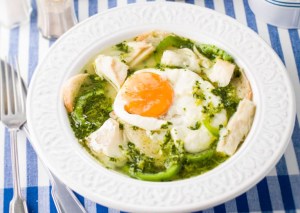
Over the centuries, the Alentejo has come up with several tasty ways of making good use of old bread. And it just so happens that açorda is one of them! To revive dry and robust country style Alentejano bread, thick slices are placed in a deep bowl, and drenched with garlic and coriander rich broth. An ultra simple recipe, which can be made on the spot and that is completed for protein and satiation with a poached egg on top.
Açorda à Alentejana is often also served with poached fish, most commonly salted cod. But, as an appetizer, a poached egg is customary. Not only is this a comforting warm soup, it can be whipped up in virtually no time, as there’s no cooking process for the dish as a whole, and more like an assembly of its several elements. If you don’t fancy coriander, pennyroyal can also be used in its place, and it’s just as typical!
Looking for a typical place to try açorda à Alentejana? Head to Casa do Alentejo.
📍Rua das Portas de Santo Antão 58, 1150-268 Lisbon
Main meals
Bacalhau à Brás
 If there’s one cod fish that you should definitely try when you visit Lisbon, this is it! Bacalhau à Brás was invented in the happening old neighborhood of Bairro Alto, and it features shredded cod sauteed with onions, fried matchstick potatoes, and eggs. The dish is finished with chopped parsley and black olives.
If there’s one cod fish that you should definitely try when you visit Lisbon, this is it! Bacalhau à Brás was invented in the happening old neighborhood of Bairro Alto, and it features shredded cod sauteed with onions, fried matchstick potatoes, and eggs. The dish is finished with chopped parsley and black olives.
Even though brás style came up as a cod recipe, the brás way of cooking is now applied to other ingredients and is considered one of the specific techniques of Portuguese cuisine. As such, you can have fried onions, ultra thin potatoes and eggs, mixed with virtually any ingredient. Apart from bacalhau, the most frequent nowadays would be prawns or, for a vegetarian version, leek.
There are plenty of Bacalhau à Brás all over Lisbon, but Laurentina – O Rei do Bacalhau has one of the very best.
📍Avenida Conde Valbom 71A, 1050-067 Lisbon
Ervilhas com ovos escalfados
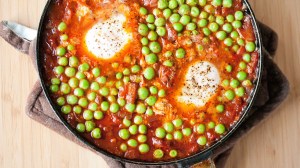 This is Portuguese winter food at its best! Green peas with poached eggs is what happens when you take tomatada mentioned above and, in the tomato based sauce, you decide to also cook plenty of peas and flavor it all with pieces of chorizo.
This is Portuguese winter food at its best! Green peas with poached eggs is what happens when you take tomatada mentioned above and, in the tomato based sauce, you decide to also cook plenty of peas and flavor it all with pieces of chorizo.
This is a stew with a big amount of protein, as it mixes legumes, eggs and some cuts of meat. No wonder this is a favorite for colder days, as it packs lots of energy. To add freshness to the palate, ervilhas com ovos escalfados is served with chopped coriander. While this is considered a rather simple dish to make at home, not everyone cooks it the same way. No matter where you try it, make sure to have some Portuguese bread in hand to dip in the richly flavored runny egg yolks!
Visit Café Lapo if you fancy sampling ervilhas com ovos escalfados
📍Rua Mal. Saldanha 26, 1200-086 Lisbon
Bitoque
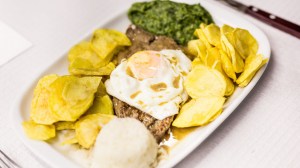 While technically not an egg dish, a bitoque wouldn’t be a bitoque without an egg. This is one of Portugal’s simplest yet quintessential meals, consisting of a thin pan-fried steak, fries, and an egg on top of the meat. Other sides such as rice or salad can algo make an appearance on the plate, but this varies depending on who’s cooking. If the cook is into a tangy aftertaste that complements beautifully the garlic marinade that is usually added to the meat, pickles can also be included as a topping. Portuguese pickles normally feature a variety of vegetables, including carrots and cauliflower.
While technically not an egg dish, a bitoque wouldn’t be a bitoque without an egg. This is one of Portugal’s simplest yet quintessential meals, consisting of a thin pan-fried steak, fries, and an egg on top of the meat. Other sides such as rice or salad can algo make an appearance on the plate, but this varies depending on who’s cooking. If the cook is into a tangy aftertaste that complements beautifully the garlic marinade that is usually added to the meat, pickles can also be included as a topping. Portuguese pickles normally feature a variety of vegetables, including carrots and cauliflower.
Bitoque is the kind of dish families often cook at home and that you can also order at a restaurant for an almost guaranteed “hit the spot” sensation. This meal is beloved by those young and old and it’s virtually available on any typical Portuguese tasca – even if you don’t see it on the menu, ask and you’ll see!
O Cardoso da Estrela d’Ouro is an emblematic eatery in Graça, which serves a mighty fine bitoque.
📍Rua da Graça 24, 1170-270 Lisbon
www.facebook.com/CardosoDaGraca
Bacalhau com todos
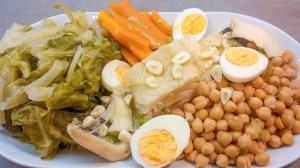 Just like bitoque, bacalhau com todos wouldn’t be complete without an egg. This salted cod dish translates as “cod with all” and all means all! Potatoes, a variety of vegetables, chickpeas and a full egg per person – all the elements are boiled and heavily drenched in olive oil and flavored with plenty of garlic. Bacalhau com todos is the traditional Portuguese Christmas Eve dinner for most families across the nation. The hard-boiled egg featured in this recipe is almost as iconic as the fish in itself!
Just like bitoque, bacalhau com todos wouldn’t be complete without an egg. This salted cod dish translates as “cod with all” and all means all! Potatoes, a variety of vegetables, chickpeas and a full egg per person – all the elements are boiled and heavily drenched in olive oil and flavored with plenty of garlic. Bacalhau com todos is the traditional Portuguese Christmas Eve dinner for most families across the nation. The hard-boiled egg featured in this recipe is almost as iconic as the fish in itself!
D’Bacalhau has cod… and all!
📍Rua do Bojador 45, 1990-254 Lisbon
Desserts
Ovos moles
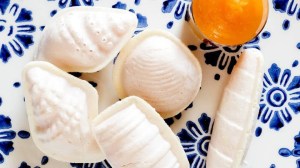 The list of Portuguese desserts made mostly of eggs is virtually never ending but ovos moles always stand out! This Portuguese recipe translates as soft eggs, and it’s basically equal parts egg yolks and sugar cooked into a smooth paste, served inside thin rice paper.
The list of Portuguese desserts made mostly of eggs is virtually never ending but ovos moles always stand out! This Portuguese recipe translates as soft eggs, and it’s basically equal parts egg yolks and sugar cooked into a smooth paste, served inside thin rice paper.
This sweet delicacy from the city of Aveiro is presented inside wafer wrappings shaped with sea inspired motifs, often sold in small wood barrels with colorful hand paintings, but can also be served in little cups meant to be eaten by the spoonful. Ovos moles are one of the most iconic Portuguese sweets, which have been granted Protected Geographical Indication by the European Union.
Try the original ovos moles brought from Aveiro at Casa dos Ovos Moles em Lisboa
📍Calçada do Sacramento 25, 1200-393 Lisbon
www.casadosovosmolesemlisboa.pt
Trouxas de ovos
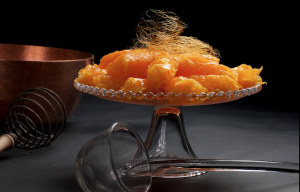 If there’s a dessert named “bundle of eggs”, you’d easily figure out what its main ingredient is! Just like ovos moles, trouxas de ovos are made with egg yolks and sugar, thus pointing us toward the eternal question that surrounds the vast repertoire of Portuguese sweets created inside convents and monasteries: how can we possibly have so many recipes that were mainly developed with egg yolks and sugar, and that still look and taste so differently amongst them? While ovos moles are cooked inside a pot, trouxas can be made in the oven, simply with a ridiculously thin layer of beaten eggs cooked in a greased tray with a little sugar.
If there’s a dessert named “bundle of eggs”, you’d easily figure out what its main ingredient is! Just like ovos moles, trouxas de ovos are made with egg yolks and sugar, thus pointing us toward the eternal question that surrounds the vast repertoire of Portuguese sweets created inside convents and monasteries: how can we possibly have so many recipes that were mainly developed with egg yolks and sugar, and that still look and taste so differently amongst them? While ovos moles are cooked inside a pot, trouxas can be made in the oven, simply with a ridiculously thin layer of beaten eggs cooked in a greased tray with a little sugar.
Once the egg yolks have solidified, you can roll them in little bundles, which are poached in syrup. This is how they soak up the sweetness that is expected in this kind of dessert. Customarily, trouxas de ovos are filled with fios de ovos, yet another egg yolk and sugar recipe, in this case, thin egg threads also boiled in sugar syrup.
Pack a bundle of trouxas de ovos at Alcôa
📍Rua Garrett 37, 1200-203 Lisbon
Pudim Abade de Priscos
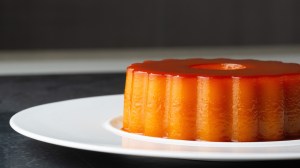 Once upon a time, in the northern city of Braga, an abbot named Priscos developed a recipe which we’d have to admit has put many believers face to face with the sin of gluttony. The pudding named after this abbot takes the Portuguese recipe of egg flan to the next level, adding a piece of bacon! The result is not savory, quite on the contrary, as this is a pudding cooked inside a caramel lined mold. Apart from bacon and a generous amount of sugar, pudim Abade de Priscos also includes copious amounts of eggs (about 15 yolks for a regular sized family pudding like shown here!), as well as lemon zest and Port wine. Sinful, but also divine.
Once upon a time, in the northern city of Braga, an abbot named Priscos developed a recipe which we’d have to admit has put many believers face to face with the sin of gluttony. The pudding named after this abbot takes the Portuguese recipe of egg flan to the next level, adding a piece of bacon! The result is not savory, quite on the contrary, as this is a pudding cooked inside a caramel lined mold. Apart from bacon and a generous amount of sugar, pudim Abade de Priscos also includes copious amounts of eggs (about 15 yolks for a regular sized family pudding like shown here!), as well as lemon zest and Port wine. Sinful, but also divine.
Sin at O Galito and confess later!
📍Rua Adelaide Cabete 7, 1500-441 Lisbon
Pão de Ló
 Portugal’s most beloved sponge cake goes by the name of pão de ló, akin to pan di Spagna in Italy and Victoria sponge in the UK. The particularity of pão de ló is that, unlike its international counterparts, it is made to be wet and runny on the inside. We also have perfectly cooked and dry sponge cakes in Portugal, but a traditional pão de ló, specially from the city of Ovar, is meant to be served still attached to the parchment paper used to bake it, and even disassemble a little when you cut into it. The outside feels like a cake, while the inside has more of a pudding-like consistency.
Portugal’s most beloved sponge cake goes by the name of pão de ló, akin to pan di Spagna in Italy and Victoria sponge in the UK. The particularity of pão de ló is that, unlike its international counterparts, it is made to be wet and runny on the inside. We also have perfectly cooked and dry sponge cakes in Portugal, but a traditional pão de ló, specially from the city of Ovar, is meant to be served still attached to the parchment paper used to bake it, and even disassemble a little when you cut into it. The outside feels like a cake, while the inside has more of a pudding-like consistency.
Pão de ló is a part of the edible history of Portugal and was taken east by Portuguese missionaries back in the 16th century, originating in the now popular Japanese kasutera cake.
O Melhor Pão de Ló do Universo claims to have the best Pão de Ló in the universe. There’s only one way to find out if that’s true…
📍Rua Nova de São Mamede 54, 1250-204 Lisbon
www.instagram.com/omelhorpaodelodouniverso
Molotof
 When you start digging into the world of Portuguese sweet recipes, you understand that most of them make use of egg yolks rather than eggs as a whole. So, what happens to all the remaining egg whites? Back in the day, egg whites had several uses besides culinary purposes. In fact, several of the recipes that make heavy use of egg yolks came about from the necessity of not wasting the egg yolks that were leftover after using the whites to starch clothes or glue gold leaf in churches.
When you start digging into the world of Portuguese sweet recipes, you understand that most of them make use of egg yolks rather than eggs as a whole. So, what happens to all the remaining egg whites? Back in the day, egg whites had several uses besides culinary purposes. In fact, several of the recipes that make heavy use of egg yolks came about from the necessity of not wasting the egg yolks that were leftover after using the whites to starch clothes or glue gold leaf in churches.
Nowadays, egg whites are mostly used in the kitchen and there are several recipes that make sure nothing goes to waste! Pudim molotof is one of them, and it consists of an egg white pudding. Picture a white, spongy and usually tall pudding, served drenched in caramel. This is a super eye-catching dessert that will easily stand out in a restaurant’s dessert counter, especially when in contrast with mostly yellow sweets.
Indulge at Os Compadres
📍Estrada Desvio 28, 1750-099 Lisbon
https://restauranteoscompadres.net
Farófias
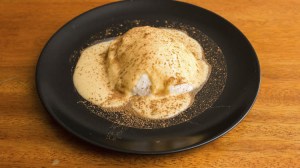 At last one dessert that values both egg yolks and whites! Farófias are Portuguese poached meringues, that is, whipped egg whites with sugar, poached in sweetened milk, flavored with lemon zest and cinnamon. These fluffy egg clouds are topped with a custard made with that same milk with added egg yolks, and served dusted with powdered cinnamon. Farófias date back to the 18th century and, while they were not heavily featured in restaurants’ menus for a while, they have been making a comeback in recent years, particularly with more contemporary twists such as fruity add-ons or nutty toppings.
At last one dessert that values both egg yolks and whites! Farófias are Portuguese poached meringues, that is, whipped egg whites with sugar, poached in sweetened milk, flavored with lemon zest and cinnamon. These fluffy egg clouds are topped with a custard made with that same milk with added egg yolks, and served dusted with powdered cinnamon. Farófias date back to the 18th century and, while they were not heavily featured in restaurants’ menus for a while, they have been making a comeback in recent years, particularly with more contemporary twists such as fruity add-ons or nutty toppings.
Order farófias and feel on cloud 9 at A Casa do Bacalhau
📍 Rua do Grilo 54, 1900-706 Lisbon
Which of these Portuguese dishes make you the most eggcited? We’d love to hear from you via Instagram ou Facebook. Please tag us: @tasteoflisboa #tasteoflisboa
Feed your curiosity on Portuguese food culture:
The World Of Portuguese Conventual Sweets
Homestyle Portuguese Food For The Winter
What Do The Portuguese Eat For Breakfast?
When Is The Best Time To Visit Lisbon?
Real people, real food. Come with us to where the locals go.
Signup for our natively curated food & cultural experiences.
Follow us for more at Instagram, Twitter e Youtube
